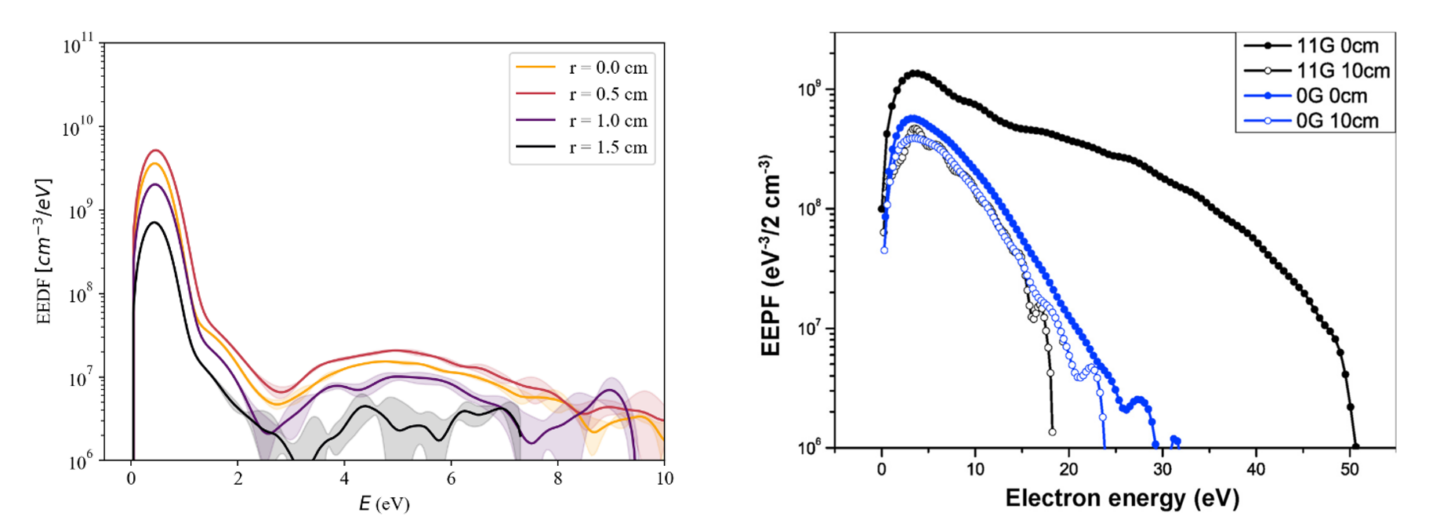Electrostatic Probes
Advanced Diagnostics Navigation
- Atomic and molecular species, positive and negative ions
- Laser-Induced Fluorescence (LIF) and Two-Photon Absorption LIF (TALIF)
- Radar Resonant Enhanced Multi-Photon Ionization (Radar REMPI)
- Characterization of plasma, chemical composition and dynamic behavior
- Electron velocity distribution function, gas flow velocity and temperature
- Electric field and space potential
- Nanoparticle Diagnostics
- Surface Diagnostics
Electrostatic Probes
- Low pressure probes
- Plasma Sensors Multifunction Plasma Probe Analyzer (MFPA)1
- Fast sweeping probe system2
- 1-100 kHz bias sweeping frequency
- Capacitance compensation up to ~1400 pF
- High pressure probes
- Swinging probe system for atmospheric pressure discharges3
At the PCRF, electrostatic probes are routinely used to quickly and effectively determine key macroscopic and kinetic plasma parameters, including the electron energy distribution function (EEDF), plasma density, electron temperature and plasma potential. Probes mounted on adjustable stages enable the acquisition of spatial profiles, and high-speed sweeping bias and acquisition enables temporally resolved measurements.

Figure 1. Cylindrical Langmuir probe immersed in e-beam generated E \times B plasma at 50 mTorr. The probe is mounted on a linear stage, enabling acquisition of radial plasma profiles. Probe biasing and data acquisition are controlled by the Plasma Sensors MFPA (top). Swinging Langmuir probe actuated by robotic servo motor, immersed in anodic carbon arc discharge at 500 Torr. The probe residence time in the hot plasma region is less than 75 ms to eliminate plasma-induced probe damage (bottom).

Figure 2. Example e-beam generated E\times B plasma EEDFs and EEPFs collected by MFPA at different radii from plasma core and varying magnetic fields; e-beam generated by iSEE cathode (left) and RF cathode4 (right).

Figure 3. Fast sweeping Langmuir probe circuit. Two insulated power amplifiers A and B, with positive and negative output terminals A+, A-, B+, and B-, are driven by a common voltage source C, and their negative outputs are connected at point D. The variable capacitor connected to B+ is tuned such that it matches the stray capacitance to ground on A+. Therefore, the capacitive current in the probe signal entering point D from A- undergoes analog subtraction by an equal capacitive current leaving point D to the B-. The analog subtracted current is then determined by measuring the current across a shunt resistor with a differential probe.2

Figure 4. Temporally oscillating electron density, plasma potential, and electron temperature of a 4 kHz rotating spoke in an e-beam generated E\times B plasma, captured by the fast sweeping Langmuir probe swept at 50 kHz ( p =0.1 mTorr Xe Penning discharge, B=40G)2.
References
- Plasma Sensors Plasma Diagnostics for Science and Technology, http://www.plasmasensors.com/.
- V. Skoutnev, P. Dourbal, E. Rodríguez, and Y. Raitses, Fast Sweeping Probe System for Characterization of Spokes in E × B Discharges 89, 123501 (2018).
- N.S. Chopra, Y. Raitses, S. Yatom, and J.M.M. Burgos, Determination of Positive Anode Sheath in Anodic Carbon Arc for Synthesis of Nanomaterials 55, 114001 (2021).
- F. Zhao, Y. Raitses, X. Yang, A. Tan, and C.G. Tully, High Hydrogen Coverage on Graphene via Low Temperature Plasma with Applied Magnetic Field 177, 244 (2021).
 This capability is located at the Princeton Plasma Physics Laboratory.
This capability is located at the Princeton Plasma Physics Laboratory.
